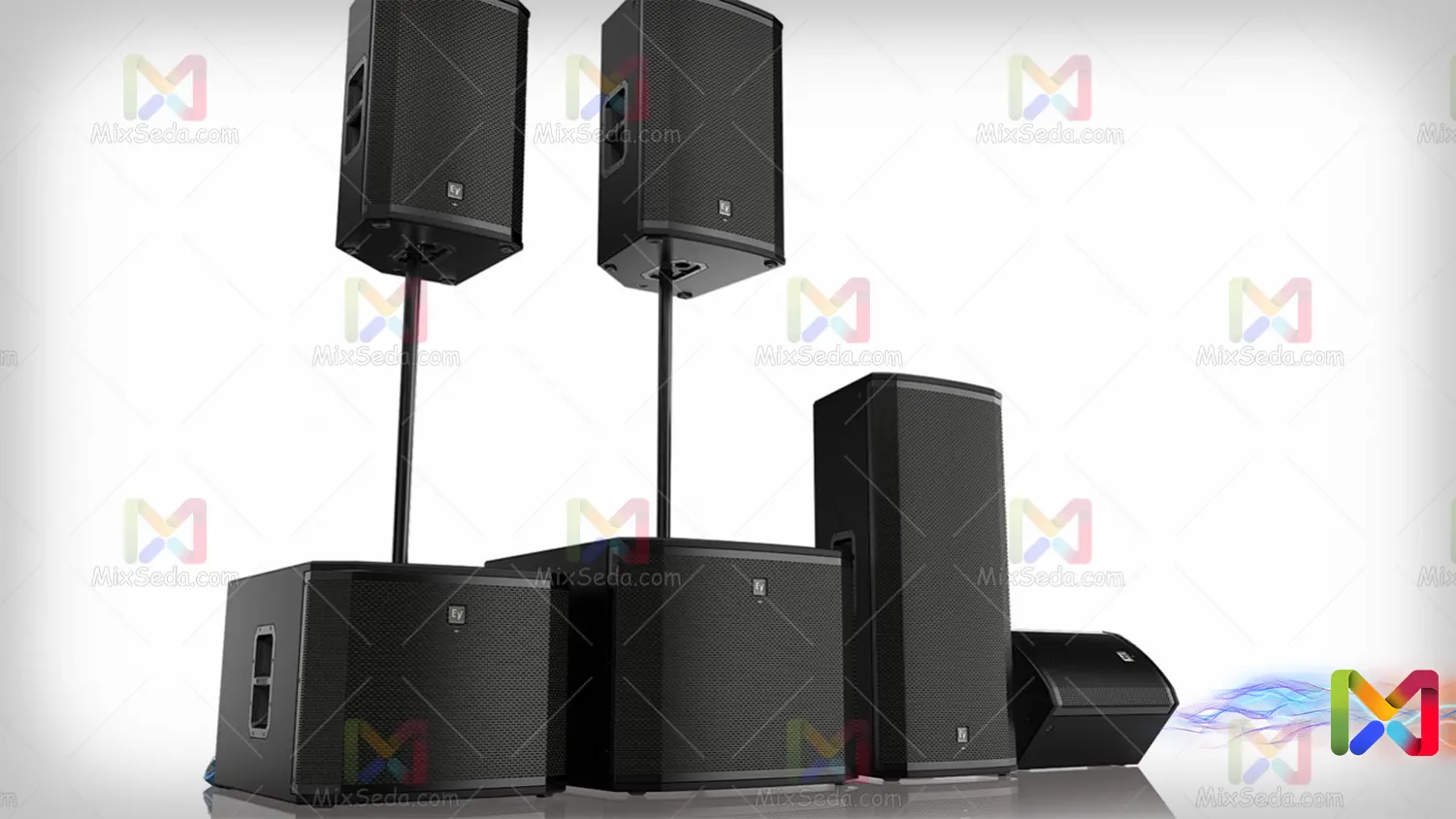
introduction
Maybe you have a question what a speaker is ... pretty much anything that can reproduce sound is called a speaker, speaker, or band. Of course, Bond's story is a bit different. In fact, bulldozers that are placed in a specific box or body are called "band".
You may be wondering what a speaker is, pretty much anything that can play audio is called a speaker, speaker, or band. In fact, speakers are devices that convert electrical energy into sound. The loudspeaker, together with the amplifier, is used to amplify the sound.
Well, the speaker consists of several parts. Each of these components does a specific job and their presence or absence can be critical or in some way non-critical.
Critical parts
Critical parts are parts of the speaker that are required in all speakers to reproduce audio. In fact, in order for a speaker to reproduce sound, these parts or components are required which can do the equivalent job of these components.
As you know, there are different types of speakers and not all of them follow the same structures and components. The vital parts of a speaker are the parts that exist in all speakers and are somehow the common point of all speakers.
These vital parts include the following:
- Diaphragm
- Surand
- Weiss Coyle
- Spider
- magnet
- basket
In the following explanation, I will explain each of these parts to you.
Cone
A good speaker needs a vibrating screen to produce sound, which is a mechanical wave. This screen is usually made in a conical way, but in rare cases it is made in a pyramid shape, three-sided, four-sided or six-sided (like some Sony brand subwoofers) and ...
This plate is usually made of plastic, foam, paper (most commonly used), aluminum. And the genre affects the sound quality, the release of the sound. And each material is used in a specific place. For example, more paper is used in paper tapes and more plastic is used in car speakers.
Surround
The sonic diaphragm needs a suand to control its movements and return to its place after each vibration.
Surround The screen is designed around the sound diaphragm and is usually made of foam, or paper, experience shows that foams are more desirable in terms of quality, strength, durability, flexibility and repairs better than paper because if paper is torn, the only way is to replace the entire speaker diaphragm.
But Surand's foam comes easily with a razor. It can be glued with iron glue.
Coil
The loudspeaker must convert electrical energy into mechanical energy (sound). We know that the use of inductors can create mechanical force.
The same thing happens with electric motors. Because the inductor around itself creates a magnetic field, and if we put this field in another field opposite to the inductor field, it becomes like two magnets that are close to each other, or if we place it in the opposite field, it's like two magnets moving away from each other. LT is.
This coil is made of lacquered copper wire, aluminum (in very rare cases) and gold (WiFi audio systems worth millions) and is best wrapped around a copper or aluminum cylinder, which is comfortable to heat. and longer speaker life.
Spider
Spider is actually a kind of heated fabric that is a bit thick, thick and hard and obviously has good flexibility in the direction of moving the voice coil. Spider's work is the same as Surandeh's, except that Surande was in control of the opening of the sound. The spider is further inside the magnet groove to control the voice coil and maintain its balance.
Magnets
A speaker can have from one to more magnets, depending on the type. The magnet is needed to create a permanent magnetic field for the moving coil.
The new and very good magnets are made of neodymium. But due to the high cost, ferrite or cerium-cobalt or alnico (a type of permanent magnet alloy) is still used instead of neodymium.
Basket (speaker body)
A basketball is an integrated piece on which all speaker components are mounted. Baskets are usually made from strong or light metals such as iron, aluminum and, in rare cases, stone! They use and use plastic and ... it's not common at all.
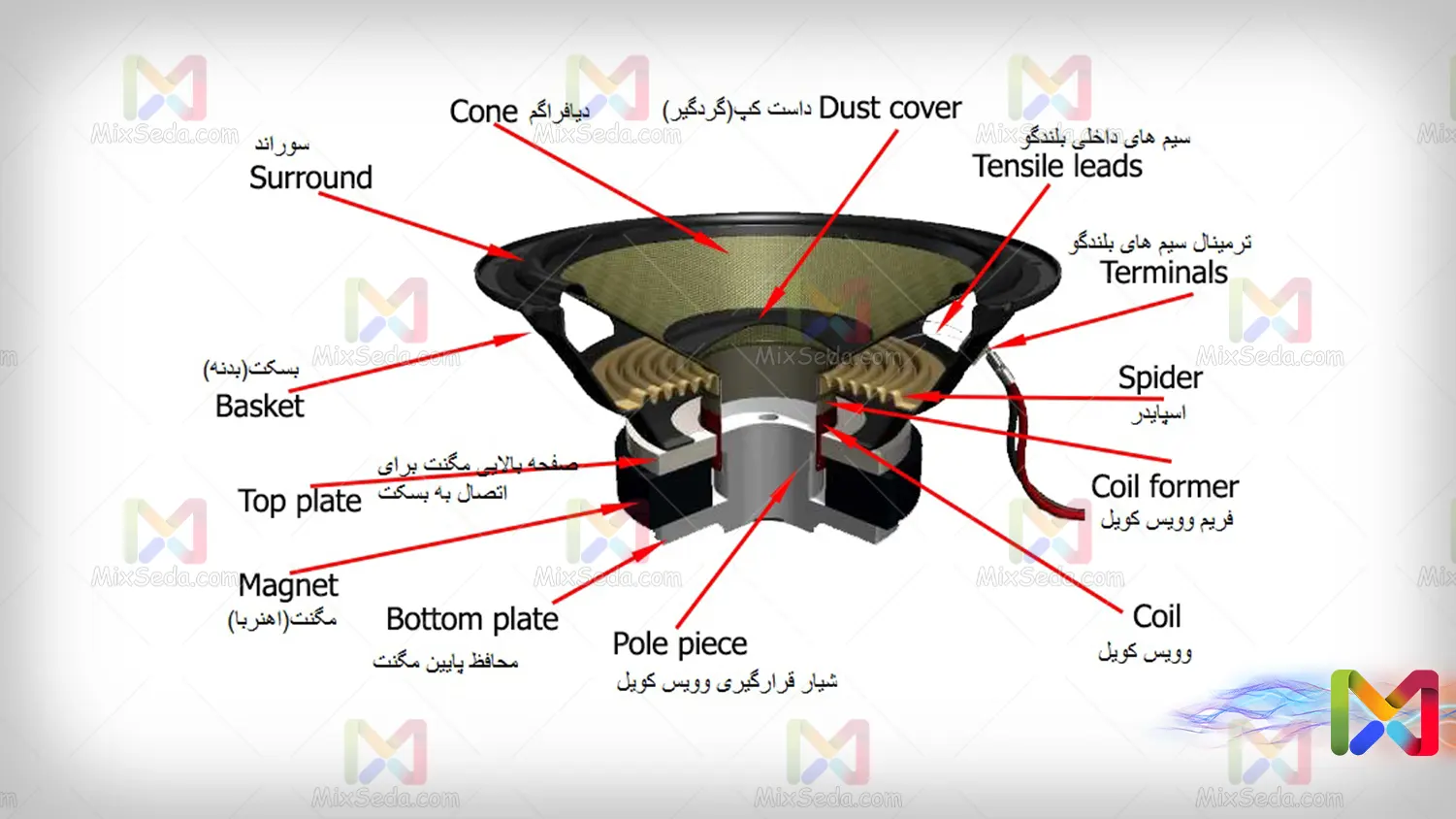
Non-critical parts
Handcuffs
The speakers use a cover, usually made of paper or plastic, to prevent dirt from entering the voice coil and causing damage or damage to the sound. The cup is located in the center of the sound opening.
Spider
It is true that we have also defined Spider as a vital part. But it can also be useless on Twitter. Because the moving coil of the tweeters is usually very light and the Twitter page itself does the weight and control of the voice coil.
Double cone
This second cone is mounted on the first cone (aperture) and its function is to help certain types of loudspeakers such as the mid range and full range in the transmission and production of high frequencies so that those frequencies are better distributed.
Using standard speakers is very important for sound quality and recording. So, if you use quality mixer for Sound design but your sound quality is still not good, one of the reasons could be improper use of the speakers.
All kinds of speakers
Speakers, like many audio equipment, have different types. Sometimes we see that speakers are classified according to the type of tweeter and their structures, but usually speakers are classified according to the type of audio frequency reproduction and the quality and functionality they have. I am going to introduce you to some of these types here.
As you know, speakers are used for sound transmission and the sound transmission process is not done the same in all environments. In fact, when it comes to sound, you buy a specific type of speaker based on what you need.
Decorative speaker
Decorative speakers are wall-mounted speakers. Of course, these speakers are of higher quality than regular in-wall speakers and are usually used where sound quality matters to us.
Most of these speakers have separate woofers and tweeters, so these speakers are easily able to separate the bass sounds from the underlying sounds and this increases their quality.
Decorative speakers are usually used in places where sound quality is important. For example, these speakers are widely used in religious places, for speeches, entertainment venues and for playing music.
Decorative bells themselves also have two different types:
- 2-way decorative speaker
- Full range decorative speaker
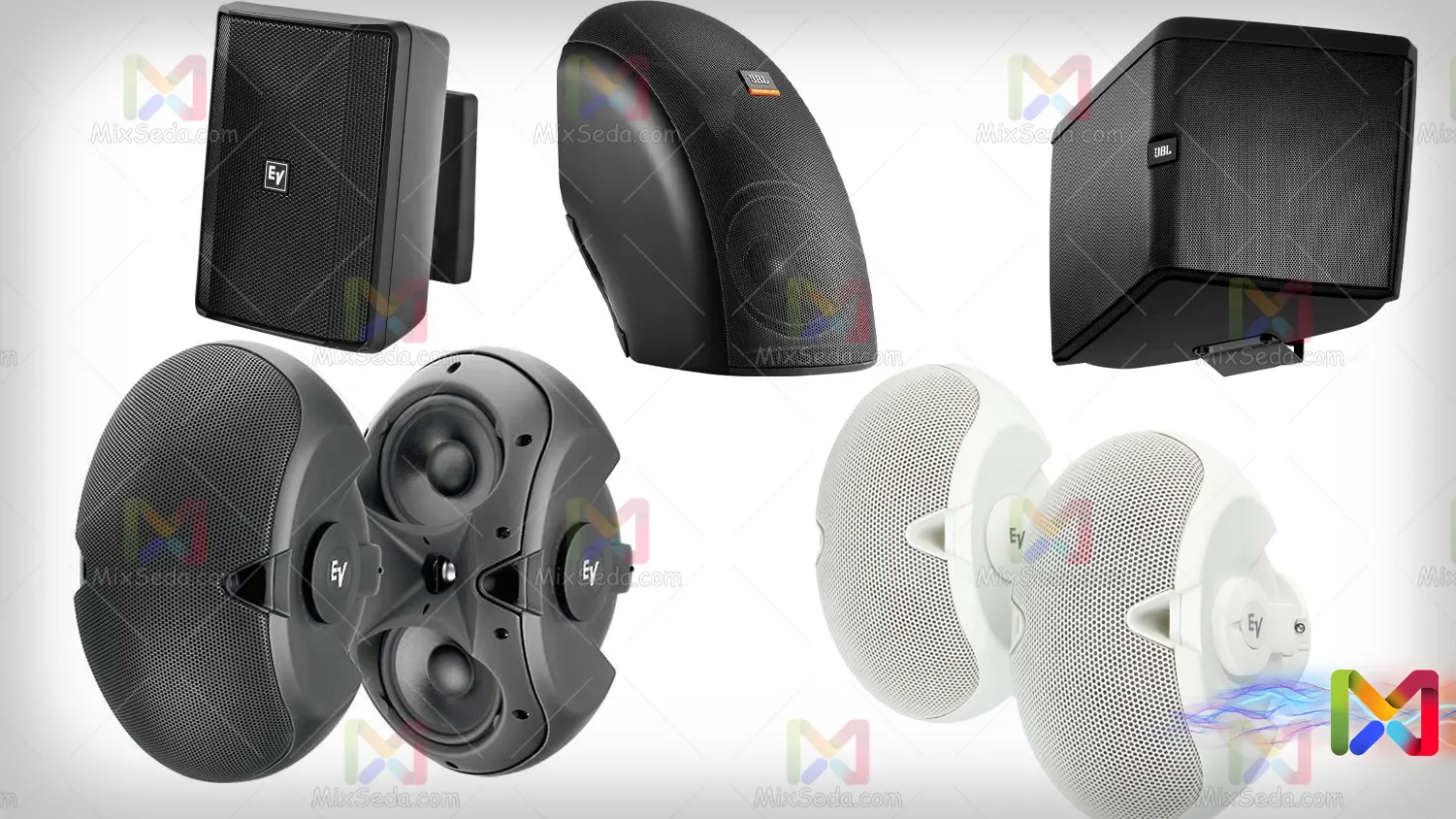
The difference between these two types is in the internal structure of these speakers. In the 2-way version of this product, we see two woofer speakers and a tweeter in the components of this speaker. Also, a crossover is responsible for separating the sound. As a result, this type of speaker produces superior quality sound.
Another type of these speakers, called full range, consists of a single speaker. These speakers have the ability to reproduce mid frequencies well. Of course, each of these types has its own uses and is used in different places.
Monitoring speaker
In studies and when compiling large projects, the most important thing is very important to you; It is the use of speakers that can provide you with the sound you are working on.
Many people prefer using a quality headphone to a monitoring speaker because headphones made for this purpose are usually cheaper and more affordable than these speakers.
But in general, monitoring speakers are usually used in studios where multiple people are supposed to be working on a project at the same time. As I said, these speakers are more expensive than other speakers. The reason is clear.
These speakers are professionally designed to deliver sound frequencies to your ears in the best possible way. The error rate of these speakers is very low and it can be said that everything you hear from these speakers is the same sound you are working on in your mixer.
Maybe if you've worked as an amateur, you've come across projects where after mixing you realized that this sound only sounds so good from your speakers and doesn't have proper EQ sound in other speakers.
This is because you didn't use any monitoring speakers during the mixing process.
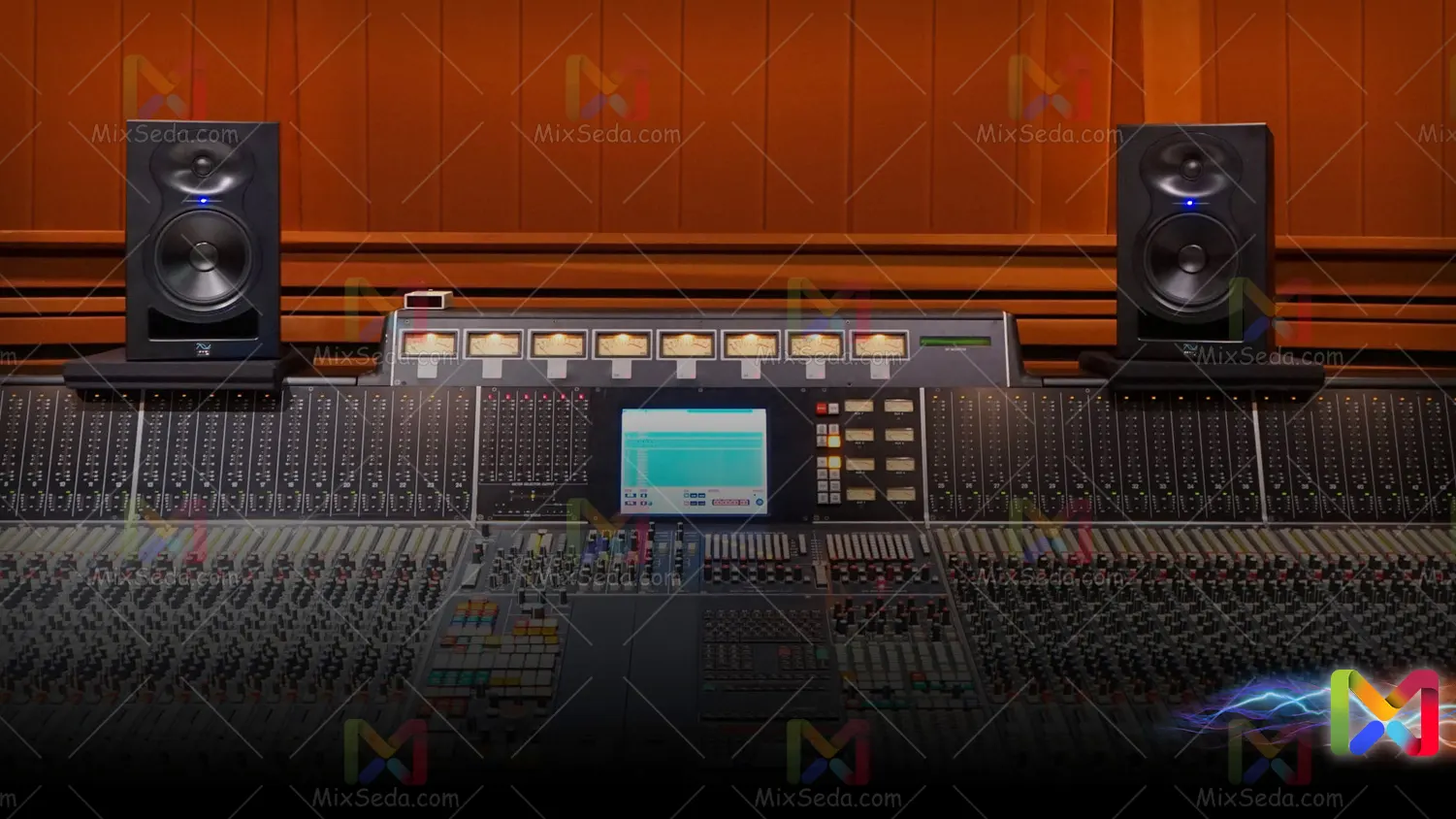
You can fully understand a music using these speakers. In fact, due to the separation of frequencies between them and the so-called clean sound, the monitoring speakers will play an audio file exactly as it was recorded.
There are several types of monitoring speakers. Some of these speakers have an internal power source and others are able to operate using an external power source. In fact, what can be said about these speakers is that they fall into the following two categories:
- active
- passive
You may find active models like many bands that have a power source inside them; Make some noise. This noise is due to the amplifier used inside this type of speaker.
Of course, this amount of noise can only be heard at a distance of a foot if you pay close attention to the output signals when the speaker is on and there is no sound coming out of it. Indeed, this amount of noise causes no interference in the output frequencies.
Wall speakers
Wall speakers are another type of speakers that can be installed on the wall. Wall speakers themselves are divided into many types. Some of these speakers are also designed to be placed exactly inside the wall.
Only one of the wall speaker subsets are decorative speakers. Another type of wall-mountable column speaker.

In home theaters and some small studios, they sometimes use wall-mounted speakers to get good sound. Also, in some places, they use these speakers instead of using other types of speakers due to space limitations.
Column speakers
Column speakers are speakers that often have a rectangular appearance and can be installed on the wall or on a base. There are many types of column speakers. Some of these speakers are used for outdoor installation.
Such speakers are of high quality and are often waterproof, dustproof and also resistant to sunlight. Due to the reasonable price of these speakers compared to other products, they are usually used in hospitals, parks and schools.
These speakers have acceptable sound quality and, thanks to their metal body, are generally more durable than other speakers. These speakers are usually used for information and we rarely see that they use these speakers independently to play music.
In fact, as I explained above, the most important principle for preparing a speaker is what you intend to use it for and where. Although the music can be played through these speakers, you will not see any restaurants or bars that use this speaker to play music.
When playback quality becomes important and you want your customers to experience impressive music; In general, you should choose decorative speakers. In short, the purpose of column speaker construction was not specifically to reproduce the highest quality sound.
Of course, in the expensive models of this product, you may also find music playback products that are tailor-made for this purpose.
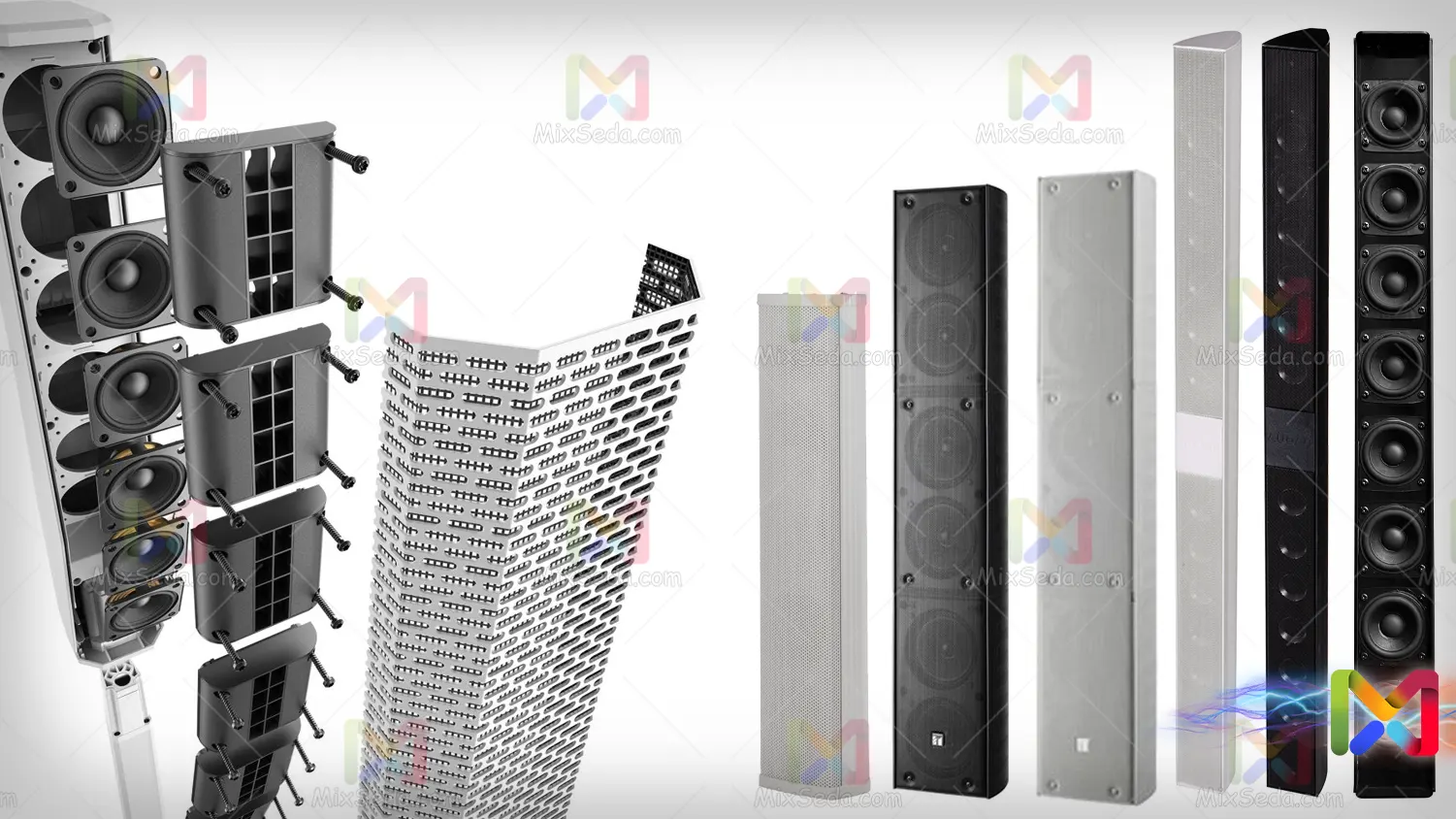
As you can see in the photo above, the column speaker structure is made up of several full-range speakers. These speakers can be used both ohmic and volt.
Sometimes, in special cases, they use woofers together with these column speakers so that their sound reaches the audience more favorably.
Horn speakers
Horn loudspeakers, also known as horn loudspeakers, are loudspeakers that use an acoustic horn to reproduce sound. Usually, these speakers have more compact components than other speakers.
Also, in this type of speakers, metal diaphragms are used to produce the sound, so the produced sound is transferred to the horn. These speakers do not have the ability to reproduce quality sound, but the sound produced by these speakers has a very high efficiency.
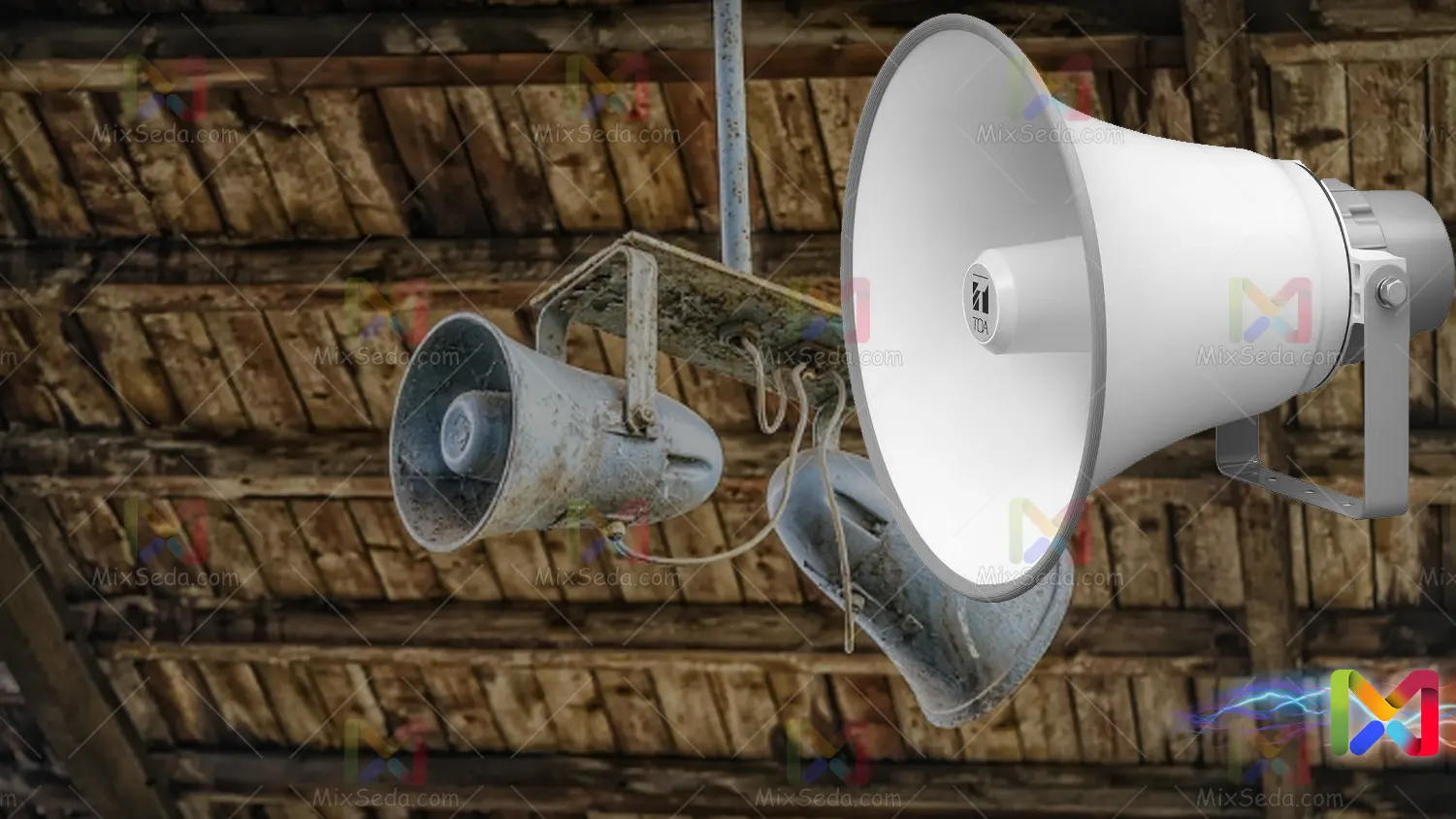
Although the existence of an unfavorable frequency answer has prevented the use of these speakers in many places, it is the cause of the capacity to produce more volume compared to other speakers, these speakers have many uses in surround systems, in stadiums and in Grand Luoghi.
Gli altoparlanti a tromba are generally classified based on the type of tromba they have. Come molti altri altoparlanti, anche questi altoparlanti hanno molti tipi. The structure of this type of speakers is used as a tutorial in many bands.
Il tipo di trombe di questi altoparlanti si calla corno e parleremo di como funzioneranno in futuro. In fact, i super tutor sono chiamati corna. I tipi di corna include quanto segue:
- Corni parabolici
- Multicella
- Trombe radiali
- Corna Traktrix
- Trombe a direzione fissa
- Corna di Mantara
- Bicorna radiali
- Trombe multicanale
Ceiling speakers
Ceiling speakers have many uses for paging. These speakers are divided into two categories based on the type of installation:
- Integrated ceiling speakers
- Ceiling speakers
The built-in ceiling speakers can be installed on the ceiling using screws or clips. These speakers are usually used when building a room or installing a suspended ceiling. And of course, before installing such speakers, you need to have done the necessary wiring.

In large buildings or organizations, these loudspeakers are typically used in corridors to inform or broadcast announcements in emergency situations. Here we will not explain how to install these built-in speakers and it is sufficient that you are familiar with these products.
In cases where the ceiling is in a single piece and it is not possible to make a hole for recessed ceiling speakers; They use the example of its coating. These speakers are usually fixed to the ceiling with screws.
Of course, these speakers are only used in cases where their built-in models cannot be installed, because the use of surface-mount equipment usually draws too much attention.
The ceiling speakers are mono and single channel. Of course, some of these speakers also feature wireless and wireless technologies based on the applications that are expected of them. For example, some of these ceiling speakers have Bluetooth technology.
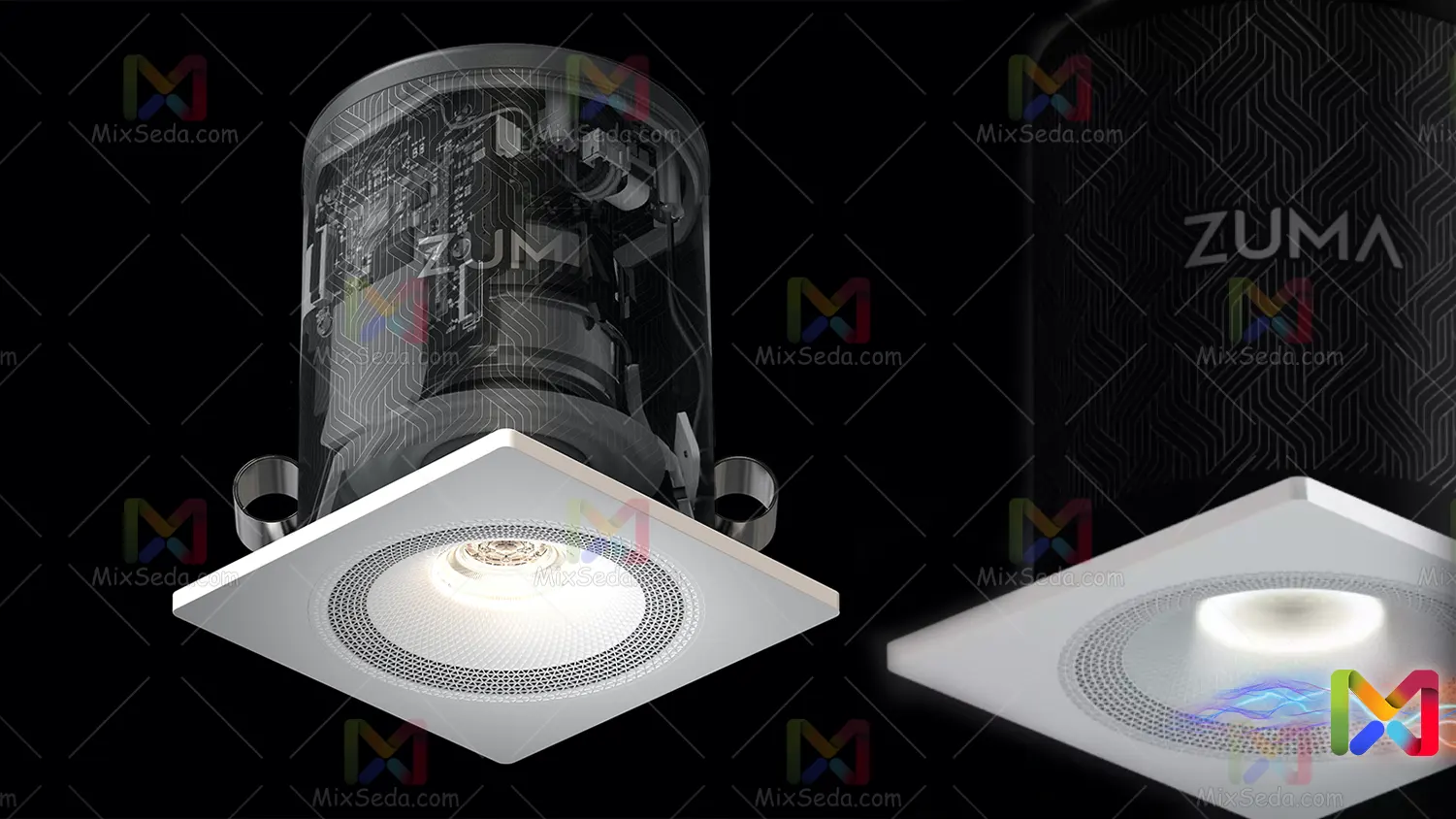
Some of these speakers also have other features such as lamps, light dancing, etc., in addition to their work.
Speaker volume measurement unit
You may have been asked how sound and sound waves are measured. The decibel is a logarithmic unit to express the relationship between a physical quantity and a specific reference. Sound intensity is also measured in decibels.
When shopping for speakerphones, headsets, and speakers, if you pay close attention to product packaging or specifications, you may have noticed that the sound intensity in all of these products is displayed in dB, which is an abbreviation for the unit of decibels.
Regarding logarithmic units, it is good to know that the decrease and increase of these units are exponential. For example, in the same decibel unit, a sound of 10dB; That's ten times a 0dB sound. But a 50dB sound is a hundred thousand times a 0dB sound.
In fact, every 10dB you add to the loudness of a sound acts as a factor of 10, and as a result, the decibel algorithm graph increases exponentially. We said about the sound intensity level, the decibel expresses the relationship between a physical quantity and a specific reference.
In the table below I have written some sound measurements in decibels:
|
Row |
Measurement reference |
sound volume |
|
1 |
The sound of a terrible explosion |
140dB |
|
2 |
pain threshold |
130dB |
|
3 |
The sound of a jet engine |
120dB |
|
4 |
The sound of rock music, the sound of children screaming |
110dB |
|
5 |
The sound of the subway |
100dB |
|
6 |
The sound of industrial machinery at a distance of one meter |
90dB |
|
7 |
The sound of a busy street, the sound of an alarm |
80dB |
|
8 |
Mobile phone ringtone |
70dB |
|
9 |
Normal conversation at a distance of one meter |
60dB |
|
10 |
Calm work environment |
50dB |
|
11 |
Quiet residential area, park environment |
40dB |
|
12 |
A quiet whisper while reading a book |
30dB |
|
13 |
The sound of clock gears |
20dB |
|
14 |
the sound of breathing |
10dB |
|
15 |
the sound of the air |
1dB-10dB |
